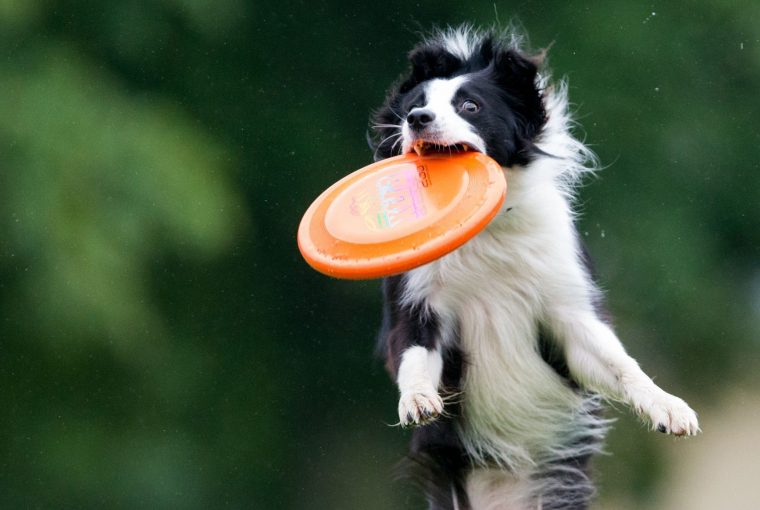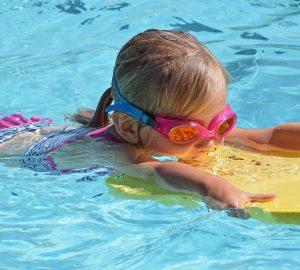Most activities are better with a four-legged friend. And, chances are, your pup is just bubbling with excitement to get moving with you. Pets are excellent motivators; your dog will almost always be thrilled to go for a run: rain, shine, or after a bad day at work. As an added bonus, that exercise is as great for your pet as it is for you.
Warm Weather Safety Tips
When you know it’s going to be really warm, exercise either early in the morning or in the evening. You’ll avoid the brunt of the heat at those times. “Remember, dogs don’t sweat like we do. They sweat through their paws,” says Sandra Hudson, owner and practitioner at Canine Rehabilitation and Conditioning Center in Austin, Texas. “If possible, do your exercising in or near water.” Being able to splash around will help your pup stay cool.
For those of you with white-haired dogs are spending time outside, keep an eye out for sunburn. Along with sunburn, pets with white ears “are more susceptible to skin cancer,” according to The Humane Society of the United States.
Brachycephalic, or the flat-faced dog breeds, may also struggle in the heat and humidity. “Keep them out of the heat as much as possible,” says Hudson.
More summertime tips:
- Always carry water, and if possible, pick a route that’s shaded.
- If your pet starts showing signs of heatstroke, take them to a veterinarian immediately.
- Careful of hot pavement—it can burn paws.
- Try to avoid the temptation to shave your long haired pets; that hair acts as insulator, keeping them cooler in the summer and protecting them from sunburn.
Now for the Fun Stuff: Exercises You Can do With Your Pet
Walking
Hopefully you’re already walking your dog daily. Walking can be a great workout. According to in a study published in The Journal Preventive Medicine, “Dog owners who reported walking their dogs were almost 25 percent less likely to be obese than people without dogs.” Plus, you and your pet will get mental and stress relieving benefits.
If possible, try to establish a routine—say one 30-minute walk in the morning and one in the evening. Your pet will appreciate the stability, and a schedule helps motivate us to get out there daily. Try out different paces and new routes to keep your daily walks fresh.
Hiking
Hiking is one of the most rewarding activities you can do with your pup. The combination of a harder workout and nature is great for mind, body, and spirit.
Hiking is a little different than other activities, since you are essentially on your own out there, especially if you’re doing a big hiking trip. For hikes, you always want to have an ID tag on your pup, bring plenty of water, and ideally, carry a first aid kit. Plan ahead. Having the right gear—like collapsing water bowls—can mean the difference between a good and bad experience.
Start off with shorter, less intense hikes and work your way up. Even though you’re just walking, hikes can get hilly and hard. It’s best to build up fitness before attempting the more strenuous hikes. For those of you already tackling shorter hikes, backcountry and thru hikes are sure to challenge you (if you and your pet accomplish such a hike, let us know!).
A few tips for hiking with your pet:
- Make sure your dog comfortable on a leash and has good recall in case he or she gets loose.
- If your dog is cautious of other people or dogs, make sure to alert other hikers.
- Pick up after your pet.
- Before you head out, check the park rules—make sure pets are allowed.
Running
Like any other intense or high-impact sport, ease your pup into running. It’s fantastic exercise for them, but just like you, they need to get in shape over time.
If you’re running on the road, always keep your dog on your left—out of the line of traffic—and on a relatively short leash. We don’t want pup zigzagging in and out of the road. For those of you lucky enough to have a trail close by, make sure that off-leash pets are allowed. Like hiking, you’ll want to carry water and make sure pup has an ID.
Tips for a successful run with your pet:
- If your dog isn’t good on-leash, try attending a basic obedience class. A well-behaved pet makes running easier on you both.
- If you have a puppy, avoid running, especially on pavement, for at least six months—possibly longer if you have a large breed. The pounding can be bad for growing bones. Please consult with your veterinarian.
- Allow time for your dog to potty before you run. Plan to spend some time walking while you both warm up.
- Have set periods to let your dog do some “doggie things” like sniffing before you start running and at the end of your run.
- Make running a game for them—most dogs love intervals, so feel free to play with pace as your fitness allows.
Biking
If you plan on taking your pup biking, you will need to make sure you have a safe attachment for your bike—one with a quick release in case of emergency.
Be prepared to spend some time getting your dog accustomed to a bike and learning to navigate next to it.
Before you go on your first ride with dog, take him on a few trial walks to get him used to the bike. Walk on the right side of the bike with your dog on the left. Try stopping, speeding up, turning, and moving over for cars. During this time, it’s helpful to incorporate verbal cues like “let’s go” and “easy.” These will come in handy during your rides.
Tips for biking with your dog:
- The easiest pace for your dog to maintain is trotting; if you see your dog getting exhausted, take a walk break.
- Always wear a helmet.
- If you’re mountain biking, it’s probably safer to have your dog off leash. Make sure the trail allows off-leash dogs, and do some easier practice runs.
Yoga
Yoga is every bit as good for your pet as it is for you, and they’ll get the same benefits. Relieving stress and strengthening your bond, yoga with pets is a combination of exercises and massage. It’s about making the most of your relationship with your pet versus forcing them into wild poses.”
Look for a “Doga” class near you.




